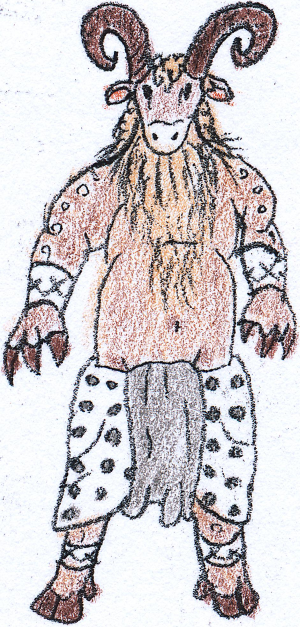Hyrríans
The Hyrríans1 are an ovine people inhabiting the Znagrúk Empire along with Gláðs, Jeihókans, Úamtnants and Znagrúks.
Their main settlement is Hyrríalúk in the northern part of the empire.
Thick, short fur covers most of the body except for the head, which has longer, curlier hair at the top and a long beard, the latter is used cover the mouth and nose during sandstorms. The fur is reddish-brown and darkens with age.
Hyrríans are crepuscular, being most active during dawn and dusk and prefer working indoors when possible during the day.
The Hyrríans expanded their territory along the banks of Húnel River, learned to domesticate local figs and other plants and were among the first people of the mountains to develop metallurgy, the latter which was later adopted by neighbouring cultures such as Kúxes, Gobíls and Znagrúks.
For a long time, the Hyrríans were bitter rivals and involved in endemic warfare with the Gláðs and later Gobíls, at which point the Znagrúks allowed the two former cultures to join their kingdom (and later empire) for protection against the latter, so long as the Hyrríans and Gláðs put an end to their wars. While old grudges still remain to some degree, the two have kept their promise so far.
Appearance and abilities
Hyrríans are distantly related to the wild sheep found in Múlíat Mountains. They are a little taller than Jeihókans but nowhere near as frail, able to traverse cliff walls and rugged terrain with ease, despite being rather chubby. Three claw-like hooves are on each hand, while the legs resemble those of wild sheep. Hyrrían men tend to have long horns on their head, while most women bald or have scurs at most.Thick, short fur covers most of the body except for the head, which has longer, curlier hair at the top and a long beard, the latter is used cover the mouth and nose during sandstorms. The fur is reddish-brown and darkens with age.
Hyrríans are crepuscular, being most active during dawn and dusk and prefer working indoors when possible during the day.
History
The first Hyrrían societies appeared in the southern Múlíat Mountains around 34.000 b.Dr, around when the ancient Zúattans dominated the region. The former initially avoided the latter, moving up into the mountains whenever the Zúattans in the valleys with their herds, but eventually settled in the area around Yrrkótap Falls and managed to hold off the Zúattans until they perished around 30.000 b.Dr.The Hyrríans expanded their territory along the banks of Húnel River, learned to domesticate local figs and other plants and were among the first people of the mountains to develop metallurgy, the latter which was later adopted by neighbouring cultures such as Kúxes, Gobíls and Znagrúks.
For a long time, the Hyrríans were bitter rivals and involved in endemic warfare with the Gláðs and later Gobíls, at which point the Znagrúks allowed the two former cultures to join their kingdom (and later empire) for protection against the latter, so long as the Hyrríans and Gláðs put an end to their wars. While old grudges still remain to some degree, the two have kept their promise so far.
Culture
Apparel
Hyrrían clothing mostly consists of loincloths, bracelets and armbands made of wool or woven plant fibers, rarely died in other colours than black and white. Common motifs include dots and crosses, both on clothing as well as body paint.Art
Architecture
Traditional Hyrrían architecture consists of simple huts built of stone, with roofs either made of straw or slate, and floors of rammed earth. Their settlements are characterized by narrow streets, with one or more small plazas acting as a place for trading and socializing. Near (or sometimes in the middle of) each plaza is a watchtower, originally used to warn the inhabitants of enemies approaching, but these days for important announcements in general.Cuisine
Hyrrían diet consists mostly of fresh or dried figs, beans, and a variety of plants which are considered inedible by other inhabitants of the empire.Sports
Hyrrían men often butt heads or wrestle each other as a test of strength. The most common sport involves two contestands standing side by side with their horns hooked together, each trying to make their opponent trip and fall. Usually performed in market squares, a common variation is for the two to stand atop a boulder for added challenge.Religion
Hyrríans traditionally don't worship any deities, instead they believe in myriad spirits that inhabit fields, orchards, rivers, rocks and houses and are constantly wandering around. Misfortune of all sorts is attributed to spirits quarreling with each other, which can be solved by sprinkling water around to scare them away. Spirits can also be angered by getting in their way, so Hyrríans generally try to not linger in the same place for too long, and particularly pious ones avoid walking down the same street, bridge or entrance twice during the day.Warfare
Hyrrían warriors favour axes and daggers in battle, and those who have horns often make use of them as well. Their armour consists of one or more bronze plate fastened to a harness, greaves and armguards.1Original icelandic: Hyrríar, singular: Hyrri




Comments